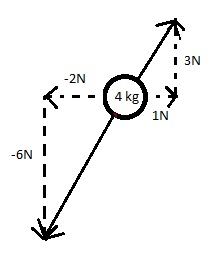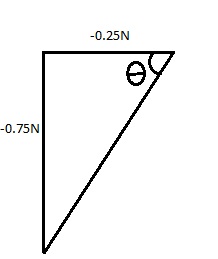An object with a mass of #4 kg# is acted on by two forces. The first is #F_1= < -2 N , -6 N># and the second is #F_2 = < 1 N, 3 N>#. What is the object's rate and direction of acceleration?
1 Answer
(If sig figs were to be accounted for, you can imagine the answer you'd get)
Explanation:
It always best to draw a diagram with the info you know:

You can already visualize that the final vector will most likely point down and to the left relative to the object.
Since you're already given the force vectors in component form, we can use the formula:
Where the mass is given (and already in the proper units):
But, we will first find the sum of each vector to find the acceleration in the x- and y- direction, then use basic trigonometry to find the final magnitude and direction.
We can then use these to find acceleration in each direction:
Then to find the vector
The angle we have here represents

So, we will add
+x-axis

